PORSCHE Cayenne User Manual

Dear Owner,
We would like to thank you for your purchase of a Porsche Cayenne. Judging by the car you have chosen, you are a motorist of a special breed, and you are probably no novice when it comes to automobiles.
Remember however, as with any vehicle, you should take time to familiarize yourself with your Porsche and its performance characteristics. Always drive within your own unique capabilities as a driver and your level of experience with your Porsche. Ensure that anyone else driving your Porsche does the same. To prevent or minimize injury, always use your safety belts. Never consume alcohol or drugs before or during the operation of your vehicle.
This Owner's Manual contains a host of useful information. Please take the time to read this manual before you drive your new Porsche.
Become familiar with the operation of your Porsche car for maximum safety and operating pleasure. The better you know your Porsche, the more pleasure you will experience driving your new car.
Always keep your Owner's Manual in the car, and give it to the new owner if you ever sell your Porsche.
A separate Maintenance Booklet explains how you can keep your Porsche in top driving condition by having it serviced regularly.
A separate Warranty and Customer Information Booklet contains detailed information about the warranties covering your Porsche.
For U.S. only:
If you believe that your vehicle has a fault which could cause a crash, injury or death, you should immediately inform the National Highway Traffic Safety Administration (NHTSA) in addition to notifying Porsche Cars North America, Inc. (Porsche Cars N.A.).
If NHTSA receives similar complaints, it may open an investigation, and if it finds that a safety problem exists in a group of vehicles, it may order a recall and remedy campaign. However, NHTSA cannot become involved in individual problems between you and your dealer, or Porsche Cars N.A.
To contact NHTSA, you may call the Vehicle Safety Hotline toll-free at 1–888–327–4236 (TTY: 1–800–424–9153); go to http://www.safercar.gov; or write to: Administrator, NHTSA, 400 Seventh Street, SW., Washington, DC 20590.
You can also obtain other information about motor vehicle safety from http://www.safercar.gov.
Your car has thousands of parts and components which have been designed and manufactured in accordance with Porsche's high standards of engineering quality and safety.
Warning!
Any alteration or misuse of the vehicle can lead to accidents and serious or fatal personal injuries.
Any alteration of the vehicle may negate or interfere with those safety features built into the vehicle. Modifications may be carried out on your vehicle only if approved by Porsche. Your Porsche is intended to be used in a safe manner obeying the local laws and in the light of driving conditions faced by you, and in accordance with the instructions provided in this Owner's Manual.
fDo not misuse your Porsche by ignoring those laws and driving conditions, or by ignoring the instructions in this manual.
Regularly check your vehicle for signs of damage.
Damaged or missing aerodynamic components such as spoilers or underside panels affect the driving behavior and therefore must be replaced immediately.
Your car may have all or some of the components described in this manual.
Should you have difficulty understanding any of the explanations of features or equipment installed in your vehicle, contact your authorized Porsche dealer. He/She will be glad to assist you. Also check with your dealer on other available options or equipment.
1

Throughout this booklet, left is designated as the driver's side of the vehicle, and right as the passenger's side of the vehicle.
Text, illustrations and specifications in this manual are based on the information available at the time of printing.
It has always been Porsche's policy to continuously improve its products. Porsche, therefore, reserves the right to make changes in design and specification, and to make additions or improvements in its product without incurring any obligation to install them on products previously manufactured.
We wish you many miles of safe and pleasurable driving in your Porsche.
Important!
For your own protection and longer service life of your car, please heed all operating instructions and special warnings. These special warnings use the safety alert symbol, followed by the words
Danger, Warning and Caution. These special warnings contain important messages regarding your safety and/or the potential for damage to your Porsche. Ignoring them could result in serious mechanical failure, serious personal injury or death.
fDo not alter your Porsche. Any alteration could create dangerous conditions or defeat safety engineering features built into your car.
fDo not misuse your Porsche. Use it safely, and consistently with the law, according to the driving conditions, and the instructions in this manual.
Alteration or misuse of your Porsche could cause accidents and serious personal injury or death.
Note to owners
In Canada, this manual is also available in French. To obtain a copy contact your dealer or write to:
Setting and operating vehicle components when driving
Warning!
There is a danger of accident if you set or operate the on-board computer, radio, navigation system, telephone or other equipment when driving.
This could distract you from the traffic and cause you to lose control of the vehicle resulting in serious personal injury or death.
fOperate the components while driving only if the traffic situation allows you to do so safely.
fCarry out any complicated operating or setting procedures only with the vehicle stationary.
Note aux proprietaires
Au Canada on peut se procurer un exemplaire de ce Manuel en français auprès du concessionaire ou du:
Porsche Cars Canada, Ltd. Automobiles Porsche Canada, LTEE
5045 Orbitor Drive Building #8, Suite 200 Mississauga, Ontario Canada L4W 4Y4
Telephone number for customer assistance: 1-800-PORSCHE / Option 3
Engine Exhaust
Danger!
Engine exhaust is dangerous if inhaled. Engine exhaust fumes have many components which you can smell. They also contain carbon monoxide (CO), which is a colorless and odorless gas.
Carbon monoxide can cause unconsciousness and even death if inhaled.
fNever start or let the engine run in an enclosed, unventilated area.
It is not recommended to sit in your car for prolonged periods with the engine on and the car not moving.
2

California Proposition 65 Warning
Warning!
Engine exhaust, some of its constituents, and certain vehicle components contain or emit chemicals known to the State of California to cause cancer and birth defects or other reproductive harm.
In addition, certain fluids contained in vehicles and certain products of component wear contain or emit chemicals known to the State of California to cause cancer and birth defects or other reproductive harm.
Hot Exhaust Pipes
Warning!
Risk of burn injury when standing near or coming into contact with the exhaust pipe.
The exhaust pipe is hot when the vehicle is running and remains hot for some time after the vehicle is turned off.
f
Portable Fuel Containers
Danger!
Portable fuel containers may leak, whether they are full or partially empty. Fuel leaking from a portable container carried in your vehicle could, in case of an accident, cause a fire or explosion, resulting in serious personal injury or death.
fNever carry additional fuel in portable containers in your vehicle.
Vehicles with SportDesign package
Caution!
Risk of damage. On vehicles with SportDesign package, front, rear, and side member trim are painted and located lower on the vehicle. Off-road driving can seriously damage these trim parts.
fWhen driving off-road, make sure these parts are not damaged.
fMake sure there is sufficient clearance between obstacles and the underside of the vehicle.
f Avoid driving through water.
fDo not use side member trim as a running board.
Porsche Ceramic Composite Brake (PCCB)
fPlease see the chapter “BRAKES” on Page 163.
The high-performance brake system is designed for optimal braking effect at all speeds and temperatures.
Certain speeds, braking forces and ambient conditions (such as temperature and humidity) therefore might cause brake noises.
Wear on the different components and braking system, such as brake pads and brake discs, depends to a great extent on the individual driving style and the conditions of use and therefore cannot be expressed in actual miles on the road.
The values communicated by Porsche are based on normal operation adapted to traffic. Wear increases considerably when the vehicle is driven on race tracks or through an aggressive driving style.
fPlease consult an authorized Porsche dealer about the current guidelines in effect before such use of your vehicle.
3
Dear Porsche Owner
A lot has gone into the manufacture of your Porsche, including advanced engineering, rigid quality control and demanding inspections. These engineering and safety features will be enhanced by you...
the safe driver...
–who knows her/his car and all controls,
–who maintains the vehicle properly,
–who uses driving skills wisely and always drives within her/his own capabilities and the level of familiarity with the vehicle.
You will find helpful hints in this manual on how to perform most of the checks listed on the following pages. If in doubt, have these checks performed by your authorized Porsche dealer.
Before driving off...
Check the following items first
fTurn the engine off before you attempt any checks or repairs on the vehicle.
fBe sure the tires are inflated correctly. Check tires for damage and tire wear.
fSee that wheel bolts are properly tightened and not loose or missing.
fCheck engine oil level, add if necessary. Make it a habit to have engine oil checked with every refueling.
fCheck all fluid levels such as windshield washer and brake fluid levels.
fBe sure the vehicle battery is well charged and cranks the engine properly.
fCheck all doors and lids for proper operation and latch them properly.
fCheck and if necessary replace worn or cracked wiper blades.
fSee that all windows are clear and unobstructed.
fCheck air intake slots and area between engine compartment lid and windshield. Ensure that these areas are free of snow and ice, so the heater and the windshield wipers work properly.
fIf a child will be riding in the vehicle, check child seat/child seat restraint system to ensure that restraints are properly adjusted.
fCheck all exterior and interior lights for operation and that the lenses are clean.
fCheck the headlights for proper aim, and if necessary, have them adjusted.
f Check under the vehicle for leaks.
f Be sure all luggage is stowed securely.
Emergency equipment
It is good practice to carry emergency equipment in your vehicle.
Some of the items you should have are: window scraper, snow brush, container or bag of sand or salt, emergency light, small shovel, first-aid kit, etc.
4
In the driver's seat...
f Check operation of the horn.
fPosition seat for easy reach of foot pedals and controls.To reduce the possibility of injury from the airbag deployment, you should always sit back as far from the steering wheel as is practical, while still maintaining full vehicle control.
fAdjust the headrest so that the upper edge of the headrest is brought to eye level or higher.
f Adjust the inside and outside rear view mirrors. f Buckle your safety belts.
f Check operation of the foot and parking brake.
fCheck all warning and indicator lights with ignition on and engine not running.
fStart engine and check all warning displays for warning symbols.
f Never leave an idling car unattended.
fLock doors from inside, especially with children in the car to prevent inadvertent opening of doors from inside or outside. Drive with doors locked.
On the road...
fNever drive after you have consumed alcohol or drugs.
f Always have your safety belt fastened.
fAlways drive defensively. Expect the unexpected.
f Use signals to indicate turns and lane changes.
fTurn on headlights at dusk or when the driving conditions warrant it.
fAlways keep a safe distance from the vehicle in front of you, depending on traffic, road and weather conditions.
fReduce speed at night and during inclement weather.
Driving in wet weather requires caution and reduced speeds, particularly on roads with standing water, as the handling characteristics of the vehicle may be impaired due to hydroplaning of the tires.
fAlways observe speed limits and obey road signs and traffic laws.
fWhen tired, get well off the road, stop and take a rest. Turn the engine off. Do not sit in the vehicle with engine idling.
Please see the chapter “ENGINE EXHAUST” on Page 2.
fWhen parked, always put the parking brake on and put the gearshift lever in neutral or the Tiptronic selector lever in position P.
On hills also turn the front wheels toward the curb.
fWhen emergency repairs become necessary, move the vehicle well off the road. Turn on the emergency flasher and use other warning devices to alert other motorists. Do not park or operate the vehicle in areas where the hot exhaust system may come in contact with dry grass, brush, spilled fuel or other flammable material.
fMake it a habit to have the engine oil checked with every refueling.
5
Break in hints for the first 2,000 miles (3,000 kilometers)
The following tips will be helpful in obtaining optimum performance from your new Porsche.
Despite the most modern, high-precision manufacturing methods, the moving parts must still wear in with each other. This wearing-in occurs mainly in the first 2,000 miles (3,000 km).
Therefore:
f Preferably take longer trips.
fAvoid frequent cold starts with short-distance driving whenever possible.
f Avoid full throttle starts and abrupt stops.
fDo not exceed maximum engine speed of 4,200 rpm (revolutions per minute).
fDo not run a cold engine at high rpm either in Neutral or in gear.
fDo not let the engine labor, especially when driving uphill. Shift to the next lower gear in time (use the most favorable rpm range).
fNever lug the engine in high gear at low speeds. This rule applies at all times, not just during the break-in period.
fDo not participate in motor racing events, sports driving schools, etc. during the first 2,000 miles (3,000 kilometers).
There may be a slight stiffness in the steering, gear-shifting or other controls during the break-in period which will gradually disappear.
Break in brake pads and brake discs
New brake pads and discs have to be “broken in”, and therefore only attain optimal friction when the car has covered several hundred miles or km.
The slightly reduced braking ability must be compensated for by pressing the brake pedal harder. This also applies whenever the brake pads and brake discs are replaced.
New tires
New tires do not have maximum traction. They tend to be slippery.
fBreak in new tires by driving at moderate speeds during the first 60 to 120 miles (100 to 200 km). Longer braking distances must be anticipated.
Engine oil and fuel consumption
During the break-in period oil and fuel consumption may be higher than normal.
fPlease see the chapter “ENGINE DATA” on Page 349.
As always, the rate of oil consumption depends on the quality and viscosity of oil, the speed at which the engine is operated, the climate and road conditions, as well as the amount of dilution and oxidation of the lubricant.
fMake a habit of checking engine oil with every refueling, add if necessary.
6

Overview Illustrations......................... |
10 |
Driver’s cockpit ............................................ |
11 |
Steering wheel and instrument cluster ............ |
12 |
Center console, front .................................... |
13 |
Opening and Locking ......................... |
14 |
Never invite car theft! .................................... |
15 |
Keys ............................................................ |
16 |
Central Locking System ................................ |
17 |
Brief overview – Opening and locking from |
|
outside ........................................................ |
18 |
Unlocking and locking from outside ................ |
19 |
Opening and locking from inside .................... |
28 |
Opening and closing the engine |
|
compartment lid ........................................... |
29 |
Malfunctions when opening and closing .......... |
31 |
Seats, Mirrors and Steering Wheel ..... |
33 |
Seat and Headrest ........................................ |
34 |
Front seat with memory................................. |
37 |
Easy Entry Function ..................................... |
39 |
Fire Extinguisher ........................................... |
40 |
Heated Seats – Front and Rear ...................... |
40 |
Safety Belts.................................................. |
42 |
Airbag Systems ............................................ |
45 |
Child Restraint Systems ................................ |
49 |
LATCH Child Seat System.............................. |
53 |
Child Restraint Anchorages............................ |
54 |
Door Mirrors................................................. |
55 |
Interior Mirror ............................................... |
57 |
Automatic Anti-Dazzle Mirror .......................... |
57 |
Steering Wheel ............................................. |
58 |
Multi-Functional Steering Wheel ...................... |
60 |
Sun Visors.................................................... |
62 |
Make-up mirror ............................................. |
62 |
Sun Blinds, Rear Side Windows ...................... |
62 |
Air Conditioning, Parking Heater and |
|
Heated Rear Window ......................... |
63 |
Opening the Cover Flap of the |
|
Air-Conditioning Control Panel ....................... |
64 |
Overview of Air-Conditioning Systems ............. |
64 |
Valid for Every Air-Conditioning System........... |
65 |
Brief Overview – Manual Air-Conditioning ...... |
66 |
Manual Air-Conditioning.................................. |
67 |
Brief Overview – Automatically Controlled |
|
2-Zone Air-Conditioning System ...................... |
69 |
Automatically Controlled |
|
2-Zone Air-Conditioning.................................. |
70 |
Brief Overview – Automatically Controlled |
|
4-Zone Air-Conditioning System, |
|
Front Control Panel ....................................... |
73 |
Brief Overview – Automatically Controlled |
|
4-Zone Air-Conditioning System, |
|
Rear Control Panel ........................................ |
74 |
Automatically Controlled |
|
4-Zone Air-Conditioning.................................. |
75 |
Vents ........................................................... |
79 |
Heated Rear Window ..................................... |
80 |
Parking Heater.............................................. |
81 |
Table of Contents |
|
Windows and Sliding Roofs ................ |
86 |
Power windows............................................. |
87 |
Brief overview - sliding/lifting roof ................ |
91 |
Sliding/Lifting Roof........................................ |
92 |
Brief overview – Panorama roof system ....... |
96 |
Panorama roof system .................................. |
97 |
Lights, Turn Signals and Windshield |
|
Wipers ............................................ |
103 |
Light Switch ............................................... |
104 |
Instrument Illumination................................. |
105 |
Automatic Headlight Beam Adjustment.......... |
106 |
Turn signal/High Beam/ |
|
Headlight Flasher Stalk ................................ |
106 |
Emergency flasher ...................................... |
107 |
Interior Lighting........................................... |
107 |
Comfort Lighting......................................... |
109 |
Coming Home Function |
|
(Auto Shut Off Delay) ................................... |
109 |
Door-Surrounding Lighting ........................... |
109 |
Brief overview – Windshield wipers............. |
110 |
Windshield Wiper/Washer Stalk .................... |
111 |
Table of Contents 7

Multi-Purpose Display |
|
and Instruments .............................. |
115 |
Instrument Panel USA Models ...................... |
117 |
Instrument Panel Canada Models.................. |
119 |
Oil Temperature Gage ................................. |
120 |
Tachometer................................................ |
120 |
Clock ......................................................... |
120 |
Fuel Gage................................................... |
120 |
Speedometer ............................................. |
120 |
Odometer .................................................. |
121 |
Voltmeter ................................................... |
121 |
Cooling System .......................................... |
122 |
Emission Control......................................... |
123 |
Operating the multi-purpose display on the |
|
instrument panel ......................................... |
124 |
Opening the main menu............................... |
125 |
Operating example: Displaying average |
|
consumption .............................................. |
125 |
Displaying/resetting average speed ............. |
127 |
Displaying range on remaining fuel ............... |
127 |
Displaying tire pressure............................... |
127 |
Displaying compass .................................... |
127 |
Displaying navigation information ................. |
127 |
Operating the telephone via the |
|
multi-purpose display .................................. |
128 |
Setting speed limit on the multi-purpose |
|
display ....................................................... |
129 |
Displaying warning messages ...................... |
130 |
Displaying status of level control .................. |
131 |
Displaying status of locks/reduction............. |
131 |
Displaying average consumption .................. |
132 |
Setting Tire Pressure Monitoring .................. |
132 |
8 Table of Contents |
|
Switching off passenger compartment |
|
monitoring on the multi-purpose display ........ |
142 |
Synchronous adjustment of door mirrors ...... |
143 |
Changing settings for opening and locking |
|
the vehicle.................................................. |
143 |
Switching daytime driving lights on/off.......... |
145 |
Setting lighting off delay .............................. |
146 |
Setting the clock......................................... |
146 |
Setting compass......................................... |
147 |
Changing language for displays.................... |
148 |
Changing units for displays .......................... |
148 |
Resetting display to factory settings ............. |
148 |
Overview of warning messages ............... |
149 |
Driving and Driving Safety ................ |
157 |
Ignition Lock/Steering Lock ......................... |
158 |
Starting and Stopping the Engine ................. |
160 |
Parking Brake ............................................. |
162 |
Brakes ....................................................... |
163 |
Cruise Control ............................................ |
167 |
Manual transmission, clutch ......................... |
169 |
Tiptronic S.................................................. |
170 |
Selector Lever Positions.............................. |
171 |
Driving Programs for On-Road and |
|
Off-Road Driving.......................................... |
177 |
Power-Transmission and |
|
Running-Gear Control Systems ..................... |
181 |
Air Suspension with Level Control and |
|
Height Adjustment....................................... |
190 |
Porsche Active Suspension Management |
|
(PASM) ....................................................... |
193 |
Porsche Dynamic Chassis Control (PDCC)..... |
194 |
Off-Road Driving.......................................... |
195 |
Luggage Compartment, |
|
Loadspace and Storage.................... |
203 |
Folding rear seats forward and returning |
|
to upright position ...................................... |
204 |
Loadspace ................................................ |
207 |
Cargo management system ........................ |
208 |
Luggage Compartment Cover ..................... |
211 |
Luggage safety net .................................... |
212 |
Ski Bag ..................................................... |
214 |
Roof Transport System............................... |
216 |
Off-road roof-mounted Headlights |
|
Cayenne S Transsyberia ............................. |
217 |
Car Audio Operation/Tips............................ |
218 |
Porsche Communication Management |
|
(PCM) ........................................................ |
220 |
iPod, USB and AUX..................................... |
221 |
Storage..................................................... |
222 |
Cupholder.................................................. |
226 |
Ashtray...................................................... |
227 |
Cigarette Lighter ........................................ |
228 |
Trailer Hitch .................................... |
229 |
Trailer Coupling.......................................... |
230 |
Loading Information.................................... |
231 |
Parking ........................................... |
236 |
Parking Aids .............................................. |
237 |
Swivelling down mirror glass as parking aid.. 241 |
|
Garage door opener ................................... |
241 |

Alarm System and Theft Protection .. 244
Alarm System and |
|
Passenger Compartment Monitoring ............ |
245 |
Maintenance and Car Care............... |
249 |
Exercise Extreme Caution when Working |
|
on your Vehicle........................................... |
250 |
Engine Oil................................................... |
251 |
Checking Engine Oil Level............................ |
252 |
Topping up Engine Oil ................................. |
253 |
Coolant Level ............................................. |
255 |
Brake-Fluid Level......................................... |
257 |
Washer Fluid............................................... |
258 |
Power Steering........................................... |
259 |
Changing Air Cleaner................................... |
260 |
Changing Particle Filter ............................... |
260 |
Automatic Transmission Fluid....................... |
260 |
Manual Transmission Oil .............................. |
260 |
Wiper Blades .............................................. |
261 |
Emission Control System............................. |
263 |
How Emission Control Works ....................... |
264 |
Fuel Economy............................................. |
265 |
Operating Your Porsche in other Countries ... |
266 |
Fuel ........................................................... |
266 |
Portable Fuel Containers ............................. |
268 |
Fuel Recommendations ............................... |
269 |
Fuel Evaporation Control ............................. |
270 |
Car Care Instructions .................................. |
270 |
Minor Repairs.................................. |
279 |
Exercise Extreme Caution |
|
when Working on your Vehicle...................... |
280 |
Tires/Wheels .............................................. |
281 |
Jack........................................................... |
291 |
Tool Kit ...................................................... |
292 |
Compressor ............................................... |
292 |
Spacers ..................................................... |
293 |
Wheel Bolts ................................................ |
293 |
Changing Wheels ........................................ |
294 |
Flat Tire...................................................... |
295 |
Lifting the Vehicle |
|
with a Lifting Platform or Garage lift.............. |
298 |
Electrical System ........................................ |
312 |
Battery....................................................... |
320 |
Replacing the remote control battery............ |
322 |
Emergency Starting with Jumper Cables ....... |
323 |
Replacing Bulbs .......................................... |
326 |
Headlights .................................................. |
327 |
Tail light ..................................................... |
336 |
License Plate Lights .................................... |
338 |
Headlight Adjustment .................................. |
339 |
Changing headlights |
|
from left to right-hand traffic ........................ |
340 |
Bulb Chart .................................................. |
342 |
Towing....................................................... |
342 |
Tire Pressure and Technical Data..... |
346 |
Vehicle Identification ................................... |
347 |
Engine Data ............................................... |
349 |
Tires, Rims, Tracks .................................... |
350 |
Tire Pressures, Cold (68 °F/20 °C).............. |
354 |
Weights ..................................................... |
356 |
Ground Clearance ...................................... |
357 |
Capacities ................................................. |
359 |
Dimensions................................................ |
360 |
Driving Performance................................... |
361 |
Index .............................................. |
362 |
Table of Contents 9

Overview Illustrations |
|
Driver’s cockpit ............................................ |
11 |
Steering wheel and instrument cluster ............ |
12 |
Center console, front .................................... |
13 |
10 Overview Illustrations
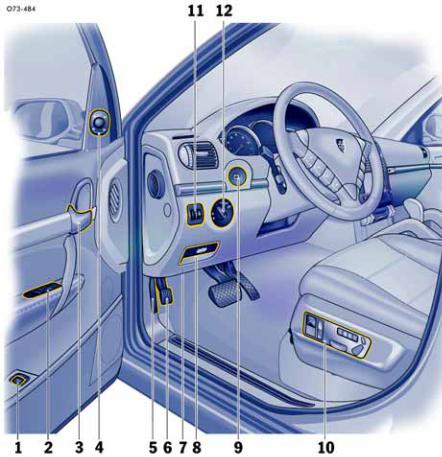
Driver’s cockpit
1.Power Lift Gate See Page 23.
2.Power Windows See Page 87.
3.Inner door Handle See Page 28.
4.Door mirror adjustment See Page 55.
5.Engine compartment lid release See Page 29.
6.Parking brake See Page 162.
7.Diagnostic socket
8.Parking brake release See Page 162.
9.Ignition lock/steering lock See Page 158.
10.Seat adjustment See Page 34.
11.Instrument lighting knob See Page 105.
12.Light switch See Page 104.
Overview Illustrations 11
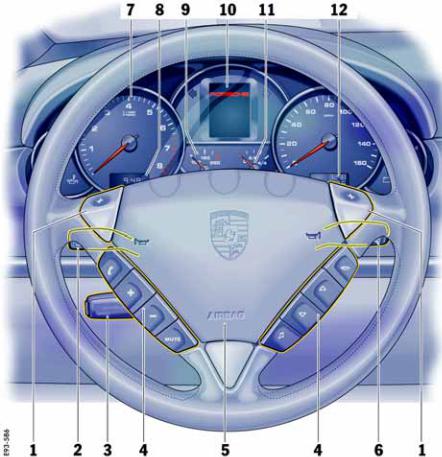
Steering wheel and instrument cluster
1.Tiptronic rocker switches See Page 58.
2.Turn signals See Page 106.
3.Cruise control See Page 167.
4.Function keys See Page 60.
5.Horn
See Page 58.
6.Windshield wipers See Page 111.
7.Tachometer See Page 120.
8.Clock
See Page 123.
9.Cooling system temperature gage See Page 122.
10.Multi-purpose display See Page 124.
11.Fuel gage
See Page 120.
12.Odometer
See Page 121.
12 Overview Illustrations
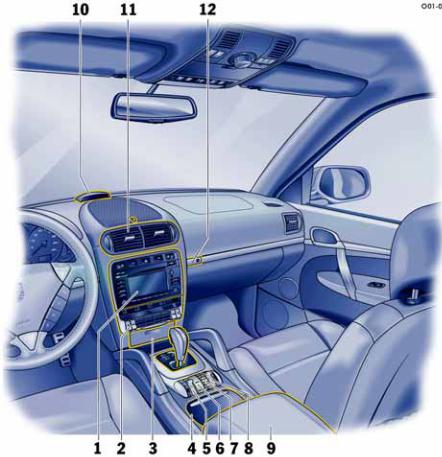
Center console, front
1.Porsche Communication Management (PCM) See separate operating instructions.
2.Air conditioner See Page 64.
3.Ashtray/cigarette lighter See Page 226.
4.Cupholder See Page 226.
5.Reduction (Low Range), differential locks See Page 177.
6.Sport mode See Page 179.
7.Porsche Active Suspension Management (PASM) running-gear setup
See Page 193.
8.Height adjustment, air suspension See Page 190.
9.Armrest, storage trays See Page 224.
10.ParkAssistent warning indicator See Page 239.
11.Vents
See Page 79.
12.Glove compartment See Page 223.
Overview Illustrations 13

Opening and Locking |
|
Never invite car theft! .................................... |
15 |
Keys ............................................................ |
16 |
Central Locking System ................................ |
17 |
Brief overview – Opening and locking from |
|
outside ........................................................ |
18 |
Unlocking and locking from outside ................ |
19 |
Opening and locking from inside .................... |
28 |
Opening and closing the engine |
|
compartment lid ........................................... |
29 |
Malfunctions when opening and closing .......... |
31 |
14 Opening and Locking
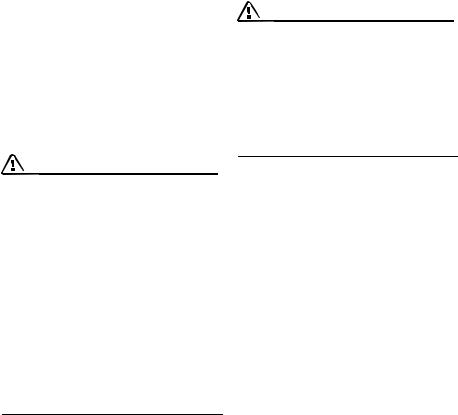
Never invite car theft!
An unlocked car with the key in the ignition lock invites car theft.
A steering wheel lock and a gong alarm are standard equipment in your Porsche. The gong alarm will sound if you open the driver's door while the key is still in the ignition lock. It is your reminder to pull the key out of the ignition lock and to lock the doors.
Warning!
Any uncontrolled movement of the vehicle may result in property damage, serious personal injury or death.
Never leave your vehicle unattended with the key in the ignition lock, especially if children and/or pets are left unattended in the vehicle. They can operate power windows and other controls. If the engine is left running, they may accidentally engage the shift lever. Serious personal injury or death could result from loss of control of the vehicle.
f Always remove the ignition key. f Always set the parking brake.
fLock the doors with the key or with the remote control.
Warning!
Risk of a serious accident.
The steering column will lock when you remove the key while you are driving or as the car is rolling to a stop. You will not be able to steer the car.
Serious personal injury or death could result from loss of control of the vehicle.
fNever remove the key from the steering lock while you are driving.
To protect your vehicle and your possessions from theft, you should always proceed as follows when leaving your vehicle:
f Close windows.
fClose sliding/lifting roof or Panorama Roof System.
fRemove ignition key (switch ignition off in vehicles that have Porsche Entry & Drive).
f Engage steering lock.
fLock storage tray between the front seats and glove compartment.
fRemove valuables (e.g. car documents, radio control module, cell phones, house keys) from the car.
f Lock doors.
f Lock the glove compartment. f Close oddment trays.
fCover luggage compartment with the luggage compartment cover.
f Close rear lid and rear window.
Opening and Locking 15

A - Car key
B - Release button for key bit
Keys
Two car keys with integrated remote control are supplied with your Porsche. The car keys are designed as folding keys.
These keys operate all the locks on your vehicle.
fBe careful with your car keys: do not part with them except under exceptional circumstances.
fInform your insurance company of any loss or theft of car keys or if extra or replacement keys have been made.
fRemove the ignition key, even if leaving the vehicle only briefly.
Folding out the key bit
fPress release button B. The key bit folds out.
Folding in the key bit
f Press release button B and fold in the key bit.
Note on operation
The air conditioner settings are stored on the respective key when switching off the ignition and locking the vehicle.
Emergency operation
fPlease see the chapter “EMERGENCY OPERATION - UNLOCKING THE IGNITION KEY” on Page 159.
Replacement keys
Car keys can only be ordered through an authorized Porsche dealer. Sometimes, this may take a long time.
You should therefore always keep a spare key on your person. Keep it in a safe place, but under no circumstances in or on the vehicle.
The key codes of new keys have to be “reported” to the vehicle control module by your authorized Porsche dealer. All keys belonging to the vehicle must also be reported again.
Note
Third parties can continue to operate the mechanical locks using the lost key.
16 Opening and Locking

Panic button
In dangerous situations or when one's own safety is threatened, it is possible to draw attention to the situation by triggering an alarm.
To trigger an alarm
fPress button.
The horn sounds and the emergency flashers flash.
To stop the alarm
fPress button again.
The horn becomes silent and the emergency flashers go out.
Central Locking System
USA: KR55WK45032
Canada: CAN 267 104 187
This device complies with: Part 15 of the FCC Rules RSS-210 of Industry Canada.
Operation of this device is subject to the following two conditions:
–It may not cause harmful interference, and
–it must accept any interference received including interference that may cause undesired operation.
Note
The manufacturer is not responsible for any radio or TV interference caused by unauthorized modifications to this equipment.
Such modification could void the user's authority to operate the equipment.
Warning!
Any changes or modifications not expressly approved by Porsche could void the user’s authority to operate this equipment.
Your vehicle is equipped with a central locking system. The following are unlocked or locked together:
–Doors
–Rear lid/rear window
–Filler flap
The central locking system is always activated when the vehicle is unlocked and locked.
On the multi-purpose display of the instrument panel, you can set different variants for locking and unlocking the doors and rear lid. You can open all doors irrespective of the setting made.
The vehicle cannot be locked if the driver’s door is not completely closed.
If one of the following components is not completely closed when you try to lock the vehicle the door/lid is not locked:
–vehicle doors
–rear lid
–rear window
–engine compartment lid
The indication by the emergency flasher and by the acoustic signal will be provided after all doors and lids are closed.
Opening and Locking 17

Brief overview – Opening and locking from outside
The Porsche Entry & Drive option can be recognized by the buttons A in the door handles.
This brief overview does not replace the information provided in the chapter “Opening and locking from outside”. In particular, warnings are not replaced by this brief overview.
What do I want to do? |
What do I have to do? |
What happens? |
||
Unlocking |
Using the key: |
on the key once. |
The emergency flasher flashes once. |
|
|
Press button |
The driver’s door can be opened. |
||
|
Press button |
on the key twice. |
All vehicle doors and the rear lid can be opened. |
|
|
With Porsche Entry & Drive: |
The doors and the rear lid |
||
|
Grip door handle fully. |
can be opened. |
||
Locking |
Using the key: |
|
The emergency flasher flashes twice and an |
|
|
Press button |
|
on the key. |
|
|
Key |
|
|
acoustic signal will sound twice. |
|
|
|
Porsche Entry & Drive |
|
With Porsche Entry & Drive: |
The doors are locked. |
|
Press the button A in the handle. |
||
|
Locking if persons/animals are remaining in vehicle
(switching off passenger compartment monitoring of the alarm system)
fPlease see the chapter “TEMPORARILY DEACTIVATING PASSENGER COMPARTMENT MONITORING SYSTEM” on Page 246.
Switching off alarm
Press button  on the key.
on the key.
18 Opening and Locking
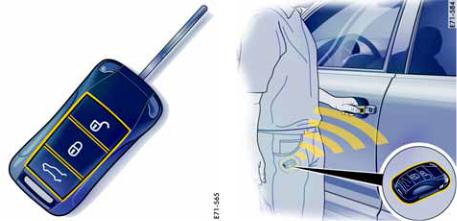
Unlocking and locking from outside
Depending on your vehicle equipment, you can either unlock and lock it with the car key or without a key by means of Porsche Entry & Drive.
With the key
Use the buttons on the key to unlock and lock the vehicle.
With Porsche Entry & Drive
On vehicles with Porsche Entry & Drive, you can unlock, lock and start the vehicle without using the key.
You simply have carry the key with you, e.g. in your trouser pocket.
Do not expose the car key to a high level of electromagnetic radiation. This could adversely affect Porsche Entry & Drive.
Readiness for operation
The Porsche Entry & Drive readiness for operation is switched off for the passenger doors after approximately 30 hours and for the driver’s door after approximately 90 hours if the vehicle is not unlocked during this period. In this case:
fPull door handle once, to reactivate the system.
f Pull door handle again, to open the door. or
fPress button  on the key to reactivate the system.
on the key to reactivate the system.
Note on operation
The factory settings of the vehicle are described in this chapter.
You can change the settings and store them on the respective key on the multi-purpose display of the instrument panel.
For further information on the possible settings on the multi-purpose display:
fPlease see the chapter “CHANGING SETTINGS FOR OPENING AND LOCKING THE VEHICLE” on Page 143.
Opening and Locking 19

Note on operation
The vehicle doors are locked automatically after 30 seconds if they are not opened.
If the passenger compartment monitoring system has been switched off (restricted theft protection), this also remains the case after automatic relocking.
The doors can be opened from inside by pulling the inner door handle twice.
Unlocking and opening doors
Unlocking driver’s door with the key
1.Briefly press button  on the key once. The emergency flasher flashes once. The driver’s door is now unlocked.
on the key once. The emergency flasher flashes once. The driver’s door is now unlocked.
2.Pull the door handle.
Unlocking all vehicle doors with the key
1.Briefly press button  on the key twice. The emergency flasher flashes once.
on the key twice. The emergency flasher flashes once.
The doors are now unlocked.
2.Pull the door handle.
20 Opening and Locking
Unlocking with Porsche Entry & Drive (keyless)
The vehicle can be unlocked if you are in the area of the driver's door with the key.
fGrip door handle fully. The doors are now unlocked.
f Pull the door handle.
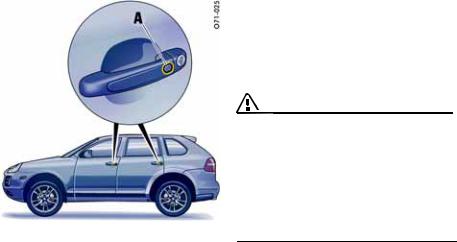
Locking doors
Locking with the key f Close the door.
fBriefly press button  on the key once. The emergency flasher flashes twice and an acoustic signal will sound twice.
on the key once. The emergency flasher flashes twice and an acoustic signal will sound twice.
fIf persons or animals remaining in the car: Please see the chapter “TEMPORARILY DEACTIVATING PASSENGER COMPARTMENT MONITORING SYSTEM” on Page 246.
Locking with Porsche Entry & Drive (keyless)
You must carry the key with you. f Close the door.
fBriefly press the Porsche Entry & Drive locking button A in the door handle.
The emergency flasher flashes twice and an acoustic signal will sound twice.
fIf persons or animals remaining in the car: Please see the chapter “TEMPORARILY DEACTIVATING PASSENGER COMPARTMENT MONITORING SYSTEM” on Page 246.
Note on operation for locking the doors
The vehicle cannot be locked if the driver’s door is open.
Automatic door locking and automatic door unlocking
Warning!
In an emergency situation where you need to exit the car through an automatically locked door, remember the following procedure to open the door.
fUnlock the doors by pressing the central locking button or
fpull the inside door handle twice to open the door.
In the multi-purpose display of the instrument panel, you have the option of selecting diverse variants of automatic door locking (AUTO LOCK) and automatic door unlocking (AUTO UNLOCK).
fFor further information:
Please see the chapter “SETTING AUTO LOCK (AUTOMATIC DOOR LOCKING) AND AUTO UNLOCK (AUTOMATIC DOOR UNLOCKING)” on Page 144.
Opening and Locking 21
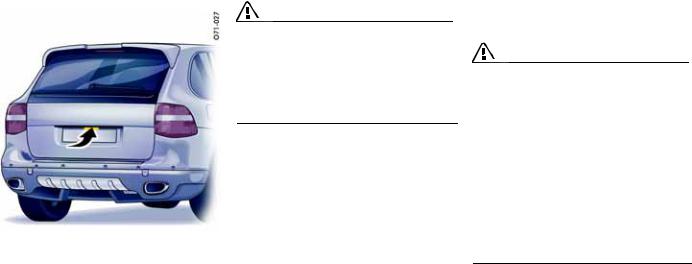
Unlocking and opening rear lid (vehicles with spare wheel bracket)
On vehicles with spare wheel bracket, this must be swung to the side before opening the rear lid.
fFor further information on opening the spare wheel bracket:
Please see the chapter “OPENING SPARE WHEEL BRACKET” on Page 310.
Danger!
Risk of poisoning. Exhaust gases can enter the passenger compartment when the rear lid is open.
fAlways keep the rear lid closed when the engine is running.
f Always keep the rear lid closed while driving.
The vehicle doors remain locked after unlocking the rear lid.
The rear lid is locked automatically after 30 seconds if it is not opened.
Unlocking with the key
f Press button  on the key.
on the key.
fPress the release handle (arrow) on the rear lid and open the rear lid.
Unlocking with Porsche Entry & Drive (keyless)
Warning!
Risk of being locked out of vehicles with Porsche Entry & Drive.
fDo not leave the key in the vehicle if the vehicle is locked and access is gained through the rear lid. The vehicle is automatically locked when the rear lid is closed.
If the key has been left in the vehicle, the emergency flasher flashes twice and a warning signal sounds. The rear lid can be opened again within approx. 30 seconds.
After 30 seconds have elapsed, the vehicle can be unlocked again only with the second key.
The rear lid is unlocked if you are in the rear area of the vehicle with the key.
fPress the release handle (arrow) on the rear lid and open the rear lid.
22 Opening and Locking
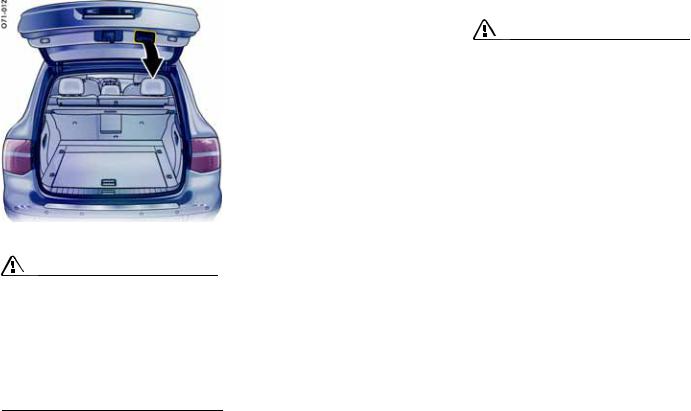
Locking the rear lid
Warning!
Danger of crushing. The rear lid is automatically pulled into the lock and locked.
fMake sure that your fingers are not under the rear lid.
fKeep foreign objects or limbs away from moving parts (latch striker) of the power closing mechanism.
f Do not leave children in the car unattended.
The rear lid has a power closing mechanism.
1.Pull down the rear lid by means of the closing handle (arrow), and press it gently into the lock.
The rear lid is automatically pulled closed and locked. (only if rear lid is unlocked)
2.Lock the vehicle.
Powerliftgate (Rear Lid)
Danger!
Risk of poisoning. Exhaust gases can enter the passenger compartment when the rear lid is open.
fAlways keep the rear lid closed when the engine is running.
f Always keep the rear lid closed while driving.
Danger of injury and damage if the rear lid is automatically opened or closed in an uncontrolled way!
f Do not leave children in the car unattended.
fOpen or close the rear lid only when the vehicle is stationary.
fNever drive with the rear window or rear lid open.
Exhaust gases can enter the passenger compartment.
fOpen or close the rear lid only when there are no persons, animals or objects within its movement range.
fAlways observe the opening and closing operation so that movement can be stopped at any time in the event of danger.
Opening and Locking 23
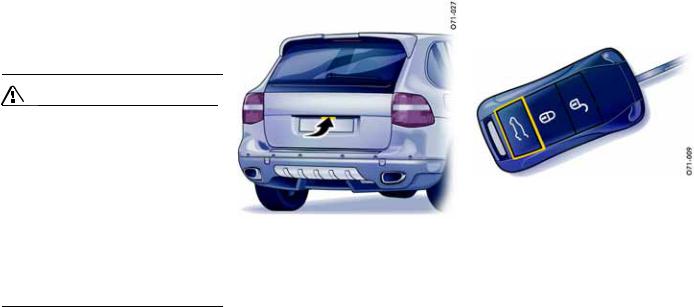
fMake sure that there is sufficient clearance behind or above the vehicle (e.g. roof transport systems, garage ceiling).
fRemove rear rack systems before opening the rear lid automatically.
Warning!
Risk of being locked out of vehicles with Porsche Entry & Drive.
fDo not leave the key in the vehicle if the vehicle is locked and access is gained through the rear window. The vehicle is automatically locked when the rear lid is closed.
If the key has been left in the vehicle, the emergency flasher flashes twice and a warning signal sounds. The rear lid can be opened again within approx. 30 seconds.
After 30 seconds have elapsed, the vehicle can be unlocked again only with the second key.
Acoustic indication during opening/closing of the rear lid
Opening and closing of the rear lid are indicated by three warning tones.
You can have the warning tones activated/deactivated at your authorized Porsche dealer.
24 Opening and Locking
Opening the rear lid automatically
When the vehicle is operated with a trailer, the rear lid can only be opened with the release button on the rear lid.
There are three ways of opening the rear lid:
Option 1
fMake sure the vehicle is unlocked if your vehicle is not equipped with Porsche Entry & Drive. Then briefly press the release handle on the rear lid.
The vehicle need not be unlocked on vehicles with Porsche Entry & Drive. You simply have carry the car key with you, e.g. in your trouser pocket.
Option 2
fPress the button  on the key for approx. 1 second.
on the key for approx. 1 second.
If the vehicle is locked, the vehicle doors remain locked when the rear lid is opened.

Option 3
fPull and hold the button in the driver’s door with the ignition switched on until the rear lid has opened fully.
Opening is interrupted if the button is released prematurely.
Automatically closing the rear lid
Make sure that the load is not in the area of the rear lid when the lid is closed, otherwise the closing operation will be interrupted after contact with the load, and the rear lid will open again by a few inches.
fBriefly press the button in the rear lid trim panel.
Interrupting the opening or closing operation in the event of danger
The opening or closing operation is interrupted immediately if one of the following buttons is pressed:
fPress the button  on the key or
on the key or
Release the button in the driver’s door or
Briefly press the button in the rear lid trim panel
or
Briefly press the release button on the rear lid.
Automatic operation can be continued again at any time. To do this, press the corresponding button.
Detection of obstacles during opening
The rear lid will stop moving if the system detects that the opening is blocked by an obstacle. A warning signal then sounds.
When the obstacle has been removed, the rear lid can be opened by pressing
the button  on the key or
on the key or
the button in the driver’s door or
the release button on the rear lid.
Opening and Locking 25
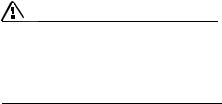
Detection of obstacles during closing
Warning!
Danger of crushing.
fDespite the presence of this detection system, you are still responsible for keeping yourself and others entirely out of the way of the door as it is closing.
The closing operation is interrupted if closing of the rear lid is blocked by an obstacle.
A warning signal sounds and the rear lid opens again by a few inches.
When the obstacle has been removed, the rear lid can be closed by pressing one of the corresponding buttons.
Adjusting the opening height of the rear lid
The opening height of the rear lid can be individually adjusted so that the rear lid does not collide with the garage ceiling, for example.
On vehicles with level control, the vehicle height changes depending on the setting of the level control system. For this reason, always adjust the opening height with the vehicle at the highest level setting so that the rear lid cannot accidentally collide with the garage ceiling, for example.
1.Stand behind the vehicle and open the rear lid.
2.Press the button  on the key to stop the automatic opening operation at around 2/3 of the opening height.
on the key to stop the automatic opening operation at around 2/3 of the opening height.
3.Now move the rear lid up by hand until the desired opening height is reached. Make sure that there is a sufficient minimum clearance from any obstacle.
4.Press and hold the button in the rear lid trim panel for approx. 3 seconds.
An acknowledgement signal sounds, and the emergency flasher lights up once.
The opening height of the rear lid has now been programmed.
The rear lid can now be closed by briefly pressing the button.
This setting cannot be deleted. If a different setting is required, repeat steps 1 to 4.
Malfunctions of the rear lid drive
The automatic function is not active if the battery voltage is too low.
If a button is pressed, the rear lid lock is unlocked and a warning signal sounds for 3 seconds. The rear lid can now be opened by hand.
f Charge the vehicle battery.
Emergency operation of the rear lid
A warning signal sounds for approx. 3 seconds if the automatic opening or closing operation is interrupted by a fault.
f Open or close the rear lid by hand.
26 Opening and Locking
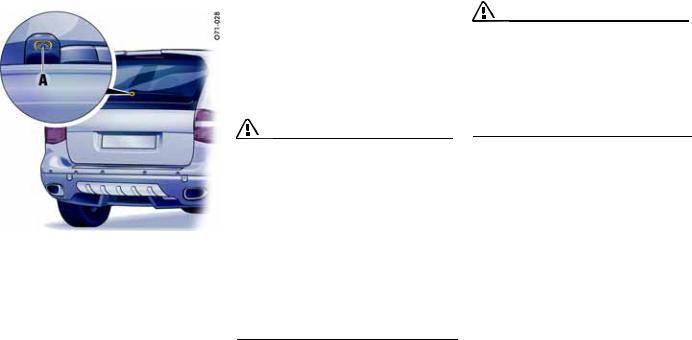
Unlocking and opening rear window
The vehicle doors remain locked after unlocking the rear lid.
The rear window is locked automatically after 30 seconds if it is not opened.
Unlocking with the key
(only on vehicles without Powerliftgate)
fPress button  on the key for approx. 2 seconds.
on the key for approx. 2 seconds.
The rear window pops open.
Unlocking with the key
1.Press button  on the key.
on the key.
2.Press the release button A and open the window.
Unlocking with Porsche Entry & Drive (keyless)
Warning!
Risk of being locked out of vehicles with Porsche Entry & Drive.
fDo not leave the key in the vehicle if the vehicle is locked and access is gained through the rear window. The vehicle is automatically locked when the rear window is closed.
If the key has been left in the vehicle, the emergency flasher flashes twice and a warning signal sounds. The rear window can be opened again within approx. 30 seconds.
After 30 seconds have elapsed, the vehicle can be unlocked again only with the second key.
Danger!
Risk of poisoning. Exhaust gases can enter the passenger compartment when the rear window is open.
fAlways keep the rear lid and rear window closed when the engine is running.
fAlways keep the rear lid and rear window closed while driving.
The rear window is unlocked if you are in the rear area of the vehicle with the key.
fPress the release button A and open the window.
Closing the rear window
Close the rear window and press it into the lock until it can be felt to engage.
Note on operation
On vehicles with Porsche Entry & Drive, the rear lid, rear window and spare wheel bracket can no longer be opened when the car key with remote control is out of range.
Opening and Locking 27

Opening and locking from inside
The factory settings of the vehicle are described in this chapter.
You can change the settings and store them on the respective key on the multi-purpose display of the instrument panel.
fFor further information on the possible settings (e.g. Auto Lock and Auto Unlock) on the multipurpose display:
Please see the chapter “CHANGING SETTINGS FOR OPENING AND LOCKING THE VEHICLE” on Page 143.
28 Opening and Locking
Locking doors
 Button in the armrest
Button in the armrest
fPress the right half of the button in the door panel.
All vehicle doors will be locked.
The doors can be opened by pulling the inner door handle twice.
Automatic with Auto Lock
The vehicle is locked automatically when a speed of 6 km/h (4 mph) is exceeded.
Unlocking doors
 Button in the armrest
Button in the armrest
fPress the left half of the button in the door panel.
If pressed on the front doors, all doors will be unlocked.
If pressed on the rear doors, only the relevant door will be unlocked.
Automatic with Auto Unlock
The vehicle is automatically unlocked when the ignition key is withdrawn or the ignition is switched off.
Note on operation
If the vehicle was locked by remote control or with the key, it cannot be unlocked with the central locking button.
Opening doors
Opening unlocked doors
f Pull inner door handle once.
Opening locked doors
f Pull inner door handle twice.
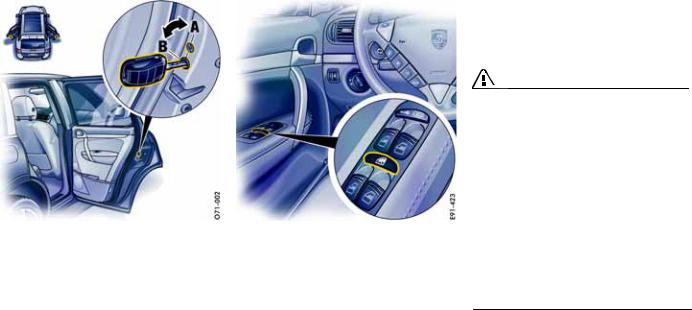
Securing rear doors
You can secure the rear doors to prevent unintentional opening when driving.
Switching child lock on and off
The child locks are fitted in the lock area of the rear doors.
The doors cannot be opened from inside when the child locks are engaged.
f To engage: Turn child lock to position A.
f To disengage: Turn child lock to position B.
 Switching child protection on/off
Switching child protection on/off
The power windows, central locking buttons on the rear doors and the rear control panel for the air conditioning can be disabled by means of the safety button in the armrest of the driver’s door.
fPress the safety button to switch child protection on and off.
The symbol in the safety button lights up if child protection is active.
Opening and closing the engine compartment lid
Opening
Caution!
Risk of damage to engine compartment lid or windshield wipers.
fMake sure that the windshield wipers are not pulled out forwards when opening the engine compartment lid.
fAlways switch the windshield wipers off (wiper stalk in position 0) before opening the engine compartment lid.
If the wiper arms are not in their final position, they will automatically move to this position when the engine compartment lid is opened. This will happen even if the ignition is off. The wiper arms remain in this position until the lid is closed and the wiper system is switched off and then on again.
Opening and Locking 29

1. Pull the release lever (arrow).
The engine compartment lid is now unlocked.
2.Unlatch safety catch A .
3.Open the lid completely.
Closing
Danger!
Risk of loss of control or an accident, resulting in serious personal injury or death.
fShould you notice at any time while driving that one of the lids is not secured properly, please stop immediately in a suitable place and close it.
The front lid may fly up impairing vision.
1.Lower lid and let it fall into the lock. If necessary, push the lid closed with the palm of your hand in the area of the lock.
2.Check that the lid has correctly engaged in the lock.
When the vehicle is in motion, a message will be displayed on the multi-purpose display of the instrument panel if the lid is not closed properly.
30 Opening and Locking
